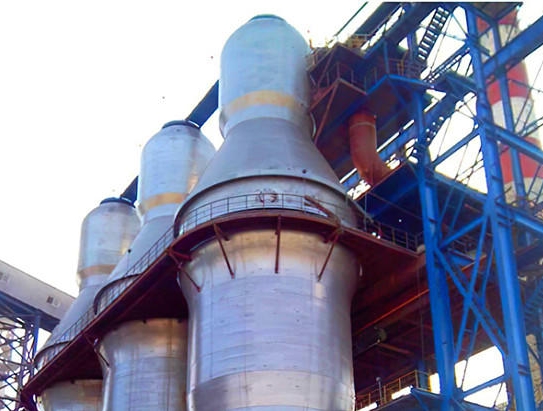- 06
- Nov
İsti partlayış sobasında daxili yanma keramika ocağının hörgü prosesi
İsti partlayış sobasında daxili yanma keramika ocağının hörgü prosesi
The overall construction process of the internal combustion ceramic burner of the hot blast stove is organized by the refractory brick manufacturer.

Daxili yanma tipli keramika brülörü mürəkkəb bir quruluşa malikdir və odadavamlı kərpiclərin bir çox xüsusiyyətləri var. Hörgü zamanı kərpiclərin tam forma və dəqiq ölçülərə malik olması tələb olunur. Xüsusi formalı kərpicləri “yoxlamaq və oturtmaq” lazımdır. İstənilən vaxt hörgünün hündürlüyünü, düzlüyünü və radiusunu yoxlayın və tənzimləyin. Dizayn və tikinti tələblərinə cavab versin.
1. Daxili yanma keramika ocağının tikinti prosesi:
(1) Brülör qurulmazdan əvvəl deflektor dizayn tələblərinə uyğun olaraq hazırlanmalı, sonra isə ocağın aşağı hissəsində alt tökmə materialı tikilməlidir.
(2) Dökmə qabının alt təbəqəsi töküldükdən sonra ödəməyə başlayın. Əvvəlcə yanma kamerasının çarpaz mərkəzi xəttini və qaz kanalının altındakı yüksəklik xəttini çəkin və onları yanma kamerasının divarında qeyd edin.
(3) Hörgünün altına odadavamlı kərpicin alt qatını, lay-lay aşağıdan yuxarıya düzmək, hörgü prosesi zamanı istənilən vaxt hörgünün hündürlüyünü və onun səthinin düzlüyünü yoxlamaq və tənzimləmək (düzlük tolerantlığı azdır) 1 mm-dən çox).
(4) Hörgü hündürlüyü artdıqca, çarpaz mərkəz xətti və hündürlük xətti eyni vaxtda yuxarıya doğru uzadılmalıdır ki, hörgü prosesi zamanı istənilən vaxt hörgü keyfiyyətinə nəzarət oluna və yoxlanıla bilsin.
(5) Alt təbəqədə odadavamlı kərpiclərin tikintisi başa çatdıqdan sonra qaz keçidinin divarını qurmağa başlayın. Tikinti ardıcıllığı da aşağıdan yuxarıya doğru aparılır. Tikinti müəyyən hündürlüyə çatdıqdan sonra tikinti divarı töküldükdən sonra tökmə materialı təbəqəsi tökülür və deflektor quraşdırılır.
(6) Deflektorun quraşdırılması:
1) Birinci təbəqə qoyulduqdan sonra onu bərkitmək üçün dəstəkləyici kərpiclərdən istifadə edin və bərkitmək üçün taxta takozlardan istifadə edin, taxta tikişləri arasında üst tökmədən istifadə edin və sıx doldurmaq üçün tökmə materialından istifadə edin.
2) Birinci qat deflektorun quraşdırılması başa çatdıqdan sonra, əvvəlki prosesi dövrələyin, qaz keçidinin divarını qurmağa davam edin, tökmə materialını tökün və sonra ikinci qat deflektorunu quraşdırın.
3) Deflektorun ikinci qatını quraşdırarkən, o, dəqiq yerinə yetirilməli, sancaq deşiyi yüksək temperaturlu yapışdırıcının 1/3 hissəsi ilə doldurulmalı və boşqablar arasındakı boşluq da tökmə materialı ilə sıx şəkildə doldurulmalıdır.
4) Geri axın plitəsini quraşdırarkən, onu bərkitməzdən əvvəl quraşdırma mövqeyinin və ölçülərinin düzgün olduğunu yoxlayın və təsdiqləyin.
5) Qaz keçid kanalının altındakı hissənin hörgü işlərini tamamlamaq üçün yuxarıdakı prosesi n-laylı deflektorda təkrarlayın.
(XNUMX) Masonry of air passage:
XNUMX) Also build from the bottom, lay the bottom bricks (flatness less than XNUMXmm), and then build refractory bricks for the air passage wall.
XNUMX) When the refractory bricks of the air passage wall reach the elevation line of the lower part of the support bricks of the gas passage chute, start pouring the wall and then pour the material. After the XNUMX to XNUMX layers of bricks above the support bricks of the gas passage chute wall are laid, the bricks will be laid again. Build refractory bricks for air passage walls.
XNUMX) When masonry reaches the burner position, a dry layer should be set at the lower part, and expansion joints should be reserved as required, and the liner should be filled with XNUMXmm refractory fiber felt and oil paper as the sliding layer. No refractory mud should be used under the oil paper to ensure the continuous sliding of the expansion joint.
XNUMX) Expansion joints should also be reserved for the gap between the burner and the surrounding castables, and the gap between the ceramic burner and the combustion chamber wall should be reserved for expansion joints according to the design requirements.
XNUMX) After the masonry of the burner nozzle is completed, fill the XNUMX° slope with castable from the corner of the eye-shaped combustion chamber to make the entire burner form a “V”-shaped mouth.
XNUMX. Masonry quality requirements of combustion chamber:
(XNUMX) According to the height line of the wall of the combustion chamber, when masonry, the refractory bricks at both ends of each layer are gradually moved to the middle, and the elevation is adjusted and controlled, and the allowable error is less than XNUMXmm. After the construction of each layer of masonry is completed, a ruler should be used to check its flatness and confirm that it meets the design and construction requirements. The geometric dimensions of each layer of refractory brick masonry should be checked and confirmed in accordance with the cross center line.
(XNUMX) When installing the deflector, keep the symmetry of the two sides of the gas duct section on the longitudinal centerline equal, and on the horizontal centerline, due to the generation of vortex cyclones, the two sides are asymmetrical. Use a tape measure to check that it meets the design and construction dimensions Require.
(XNUMX) The brick joints of the ceramic burner masonry should be filled with full and dense refractory mud to ensure its tightness and avoid mutual leakage of coal/air.
(XNUMX) The reserved position and size of the expansion joints of refractory bricks should be uniform, appropriate and meet the design and construction requirements. Longitudinal through seams should be set with standard wooden strips to ensure the accuracy of their verticality and size.
(XNUMX) During the pouring process of the castable, if the position of the following material is too high, it is necessary to use a chute for slope sliding. During the pouring and vibrating process, the vibrator should not be close to the airway wall to avoid compression and deformation of the coal/air wall.
(XNUMX) During the transportation and movement of refractory bricks, care should be taken to avoid hidden hazards such as incompleteness, cracks, and damage due to collision. The emergence of hidden dangers such as cracks.
